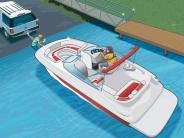Boat Ramp Etiquette
Boat Ramp Etiquette
To avoid unnecessary delays and blocking the boat ramp when launching and retrieving your boat, complete as much of the preparation, loading, and unloading in the “staging area” as possible. Others will appreciate your preparation and consideration. Here are some tips to help you. NOTE: Launching conditions vary with each boat ramp and with different water and tide levels. Launching should progress slowly until you are familiar with the ramp and water levels. Adapt the following common steps as needed for safe launch and retrieval.
Launching your vessel from a trailer:
Prepare your vessel well away from the boat ramp.
~Check that all required safety equipment and the vessel’s registration card are on board.
~Make sure the trailer coupler is connected securely to the ball hitch and unplug the trailer lights.
~Check the condition of the battery, the motor, and the angle of the drive unit.
~Make sure the vessel’s drain plug is firmly in place.
Move the vessel to the boat ramp.
Having a lookout or someone in the boat is helpful at this point.
~Check the drive unit prior to backing down the ramp.
~Run the exhaust blower, if the vessel is so equipped, for at least four minutes.
~Back the trailer down the ramp to the water’s edge. Remove all engine and transom tie-down straps.
~Back the trailer into the water until the vessel is in sufficient water depth to lower the drive unit.
~Unhook the winch line, but be sure you have a line to the bow or side cleats to control the boat.
Lower the drive unit and start the engine. Once it is running steadily, back the vessel slowly off the trailer.
Move the vessel out of the way. Secure it to a courtesy dock while you pick up your passengers.
Quickly move the towing vehicle off the ramp.
Use at least two experienced people to launch and retrieve the vessel.
Retrieving your vessel:
~Back the trailer into the water so that approximately two-thirds of the rollers or bunks are submerged.
~Move the vessel onto the trailer far enough to attach the winch line to the bow eye of the vessel. Finish pulling it onto the trailer by cranking the winch.
~Consider adding an additional bow safety chain to secure the bow eye to the trailer.
~Shut off the vessel’s engine, and raise the drive unit.
~Tow the vessel off the ramp and out of the way of others.
~In the staging area, secure the vessel to the trailer with the tie-down straps.
Before leaving the staging area:
~Remove all plants and animals from the vessel and trailer.
~Remove the drain plug.
~Drain all live wells, holds, and the bilge in a location that will not contaminate the waterway.
Courtesy on the boat ramp:
~Prepare your vessel for launching or for the drive home well away from the ramp.
~Use at least two experienced people to launch and retrieve the vessel—one to drive the towing vehicle and one to operate the vessel.
~Never block a ramp with an unattended vessel or vehicle.
~When retrieving, do not pull your vessel into a launch lane until the towing vehicle is at the ramp.
~The line is formed by vehicles with trailers, not by vessels in the water.
Do Not Power Load Your Boat
Propellor wash can erode the sediment just beyond the ramp surface, creating a large hole. The eroded sediment is deposited behind the propeller, creating a mound. Trailer tires can get stuck in these holes, and boats can run aground on the mound.


